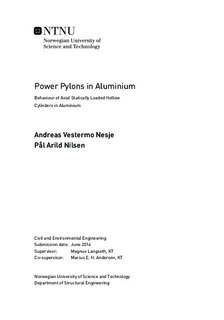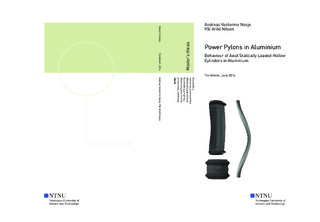| dc.contributor.advisor | Langseth, Magnus | |
| dc.contributor.advisor | E. H. Andersen, Marius | |
| dc.contributor.author | Nesje, Andreas Vestermo | |
| dc.contributor.author | Nilsen, Pål Arild | |
| dc.date.accessioned | 2019-09-11T08:35:02Z | |
| dc.date.available | 2019-09-11T08:35:02Z | |
| dc.date.created | 2016-06-10 | |
| dc.date.issued | 2016 | |
| dc.identifier | ntnudaim:15051 | |
| dc.identifier.uri | http://hdl.handle.net/11250/2614910 | |
| dc.description.abstract | This thesis studies the behaviour of axial statically loaded circular hollow cylinders in aluminium and is written as a part of the project Design of power pylons in aluminium customized for automatic production .
Theoretical approaches regarding mechanics of instability and plasticity, including guidelines from Eurocode 9, were expounded. The buckling behaviour was studied up to the point of maximum load for cylinders with various lengths, and the effect of inelastic behaviour was discussed. These approaches were compared to conducted compression tests from laboratory and finite element analyses (FEA).
T6-tempered aluminium alloys 6060 and 6082 were analysed for two cross-sections with r/t relationship 10 and 35.
The choices behind FEA modelling in the finite element method (FEM) software Abaqus was elaborated and discussed. Intended laboratory setup with low-friction spherical BCs was discarded based on preliminary FEM analyses of the setup, as results displayed an unachievable strict limit for friction. Three types of laboratory setups were conducted: Dog bone specimen tension test, short stub column compression tests with lengths two and four times the diameter and compression tests of two metres long cylinders. Measurements of geometry were discharged for all sessions and the influence of deviations are assessed.
Material behaviour on a basis of tension tests was thoroughly adapted to fit Voce hardening law. Digital image correlation was applied to extract strain data, and the material calibration process involved broad data-treatment due to several challenges in material behaviour and numerical results. Using the results in compression tests rendered 2-4 percent underestimation of capacity for 6060T6 and 6-7 percent for 6082T6.
Calibration of FEA model with a broad parameter study focusing on mesh and imperfections led to a partially robust model regarding compression of cylinders with clamped boundary conditions. The slenderest cross-section presented a challenge, as introducing a necessary global imperfection to the FEA caused it to predict a global buckling mode on cylinders that in laboratory were observed to buckle locally.
Results from laboratory, FEM analyses, analytical solutions and recommendations from Eurocode 9 were compared. The Eurocode predicted correct failure mode, but estimations were conservative with an underestimation of up to 16 percent. The analytical solutions had higher capacity accuracy and the FEM analyses even more so, but both these failed at predicting correct failure mode for some profiles. The FEA model predicted correct failure mode on all except the slenderest, longest profile, and less than 7 percent deviation in capacity compared to the compression tests. | en |
| dc.language | eng | |
| dc.publisher | NTNU | |
| dc.subject | Bygg- og miljøteknikk, Beregningsmekanikk | en |
| dc.subject | Bygg- og miljøteknikk, Prosjektering av konstruksjoner | en |
| dc.title | Power Pylons in Aluminium - Behaviour of Axial Statically Loaded Hollow Cylinders in Aluminium | en |
| dc.type | Master thesis | en |
| dc.source.pagenumber | 237 | |
| dc.contributor.department | Norges teknisk-naturvitenskapelige universitet, Fakultet for ingeniørvitenskap,Institutt for konstruksjonsteknikk | nb_NO |

